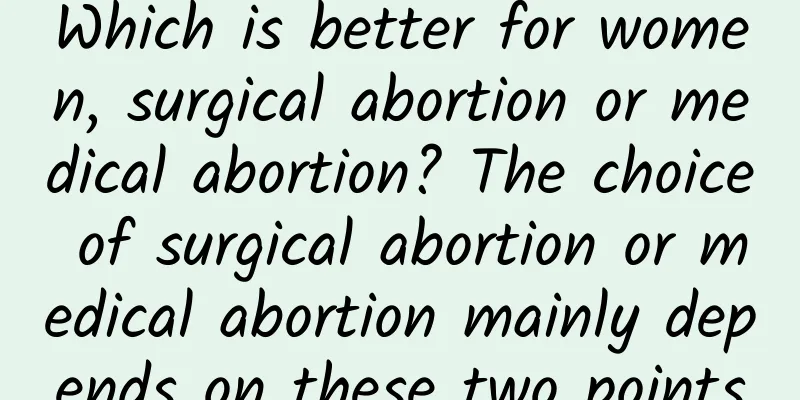Always pay attention to the dangers of ectopic pregnancy

|
In recent years, the harm of ectopic pregnancy has been spreading, but for most patients, it is because they do not pay attention to the harm of ectopic pregnancy and do not receive timely treatment, which leads to the deterioration of the condition. Let's take a look at the harm of ectopic pregnancy. After tubal pregnancy, due to the thin wall of the fallopian tube, the inner wall mucosa and submucosal tissue are very weak or incomplete, when the fertilized egg develops to a certain stage, it will cause tubal pregnancy miscarriage or tubal pregnancy rupture and internal bleeding. The fallopian tube muscles are weak and cannot contract and compress the blood sinuses like the uterus to effectively stop bleeding. If there is heavy bleeding, it can cause shock. This is the harm of ectopic pregnancy. About 1/3 of ectopic pregnancy patients are in a state of pre-shock or shock when they are admitted to the hospital. The severity of the shock depends on the amount of internal bleeding and the speed of blood loss, which is not proportional to the amount of vaginal bleeding. For example, if the pregnancy is in the fallopian tube to the hyaloid part (a section of the fallopian tube inside the uterine wall), the fetus will not rupture until 3 to 4 months of development because the lumen is surrounded by uterine muscles. This is the place where the uterine blood vessels and ovarian blood vessels converge, and the blood vessels are rich. Once ruptured, a large amount of intra-abdominal bleeding will occur in a very short time. If it is not rescued quickly, it will be life-threatening. This is the harm of ectopic pregnancy. (I) The wall of the fallopian tube is thin, and it lacks complete decidua and submucosal tissue. After the fertilized egg implants, the villi erode the muscular layer of the tube wall, destroying the microvessels in the muscular layer and causing bleeding. When the pregnancy reaches a certain stage, it will inevitably lead to the following results: ① Tubal pregnancy abortion. It often occurs in ampulla pregnancy of the fallopian tube. When the embryonic sac bulges into the tubal cavity, due to the fragility of its capsule tissue, it often ruptures and bleeds at 6 to 12 weeks of pregnancy, and the fertilized egg is discharged into the abdominal cavity from the umbrella end through the fallopian tube. If the embryo is completely peeled off and flows into the abdominal cavity, it will form a complete tubal abortion, and the amount of bleeding is generally less. If the embryonic sac is not completely peeled off, it is partially discharged, and some villi are still attached to the tube wall, it is an incomplete tubal abortion. At this time, the trophoblast cells can remain active for a considerable period of time and continue to erode the tubal tissue, causing repeated bleeding. When a large amount of blood flows into the abdominal cavity, it can cause shock. The embryonic tissue after tubal abortion is finally absorbed. ② Rupture of tubal pregnancy. After the fertilized egg implants in the fallopian tube, the villi erode the muscle layer and serosa, and finally penetrate the tube wall, resulting in a ruptured tubal pregnancy. The fertilized egg is discharged from the fissure, and a large amount of blood flows into the abdominal cavity. In severe cases, it can cause shock. Pregnancy in the isthmus of the fallopian tube often ruptures around 6 weeks of pregnancy. Rupture of ampulla of the fallopian tube pregnancy often occurs between 8 and 12 weeks of pregnancy. In the interstitial part of the fallopian tube, because the lumen here is surrounded by the uterine muscle layer, rupture will not occur until the fetus develops to 3 to 4 months. Since this area is rich in blood vessels, once ruptured, a large amount of internal bleeding can occur, which can be life-threatening. Regardless of whether the fallopian tube pregnancy is aborted or ruptured, if it is not treated in time after the onset of the disease, the fertilized egg has died, the internal bleeding gradually stops, and a hematoma mass is formed. After a period of time, the hematoma becomes organized and hardened, and adheres to the surrounding tissues, which is called a chronic ectopic pregnancy. ③ Secondary abdominal pregnancy. After the fallopian tube pregnancy is aborted or ruptured, the embryo or fetus has been discharged from the perforation or the end of the umbrella, but it still maintains blood supply with the original implantation site. Later, the placental tissue gradually grows outward from the damaged site, attaches to the uterus, fallopian tube, broad ligament or surrounding intestine and pelvic peritoneum, etc. The embryo or fetus continues to grow and develop, forming a secondary abdominal pregnancy. After the diagnosis is confirmed, the fetus should be removed by cesarean section. The placenta is implanted in the intestine or pelvic organs, and it will cause a lot of bleeding when it is peeled off. It should be handled carefully according to the situation. After causing the harm of ectopic pregnancy, the fetus dies, and the corpse turns into a stone fetus over time. (II) Changes in the uterus Tubal pregnancy has the same endocrine changes as intrauterine pregnancy. The hCG produced by trophoblast maintains the growth of the corpus luteum, increases the secretion of steroid hormones, enlarges the uterus and softens, and the endometrium shows a decidual reaction. If the embryo dies, the decidua degenerates and triangular decidual casts can be discharged. If the discharged decidua is placed in clear water, no floating villi can be seen with the naked eye, and no trophoblast cells can be found under the microscope. The endometrium shows proliferative changes, and sometimes Arias-stella (AS) reactions can be seen. The information described above is about the dangers of ectopic pregnancy. It can be seen from the above text that the dangers of ectopic pregnancy are very serious. After listening to the experts' analysis of the dangers of ectopic pregnancy, we must always pay attention to it. Here I wish you a speedy recovery. |
<<: Symptoms of ectopic pregnancy can be summarized into three categories:
>>: The harm of pelvic inflammatory disease can seriously affect fertility problems
Recommend
Is it normal to have a period every 35 days?
A 35-day menstrual cycle is generally considered ...
What precautions should patients with pelvic inflammatory disease take in their daily lives?
What precautions should patients with pelvic infl...
Is it okay to do laparoscopy for pelvic effusion?
Laparoscope is similar to electronic gastroscope,...
Eat a lot during the Chinese New Year without gaining weight. Doctors do this to lose weight
During Chinese New Year, it is most appropriate t...
Hyperprolactinemia treatment method
Hyperprolactinemia is a disease of the pituitary ...
What are the symptoms of amenorrhea in women
What are the symptoms of amenorrhea in women? Ame...
Can sauna and massage remove subcutaneous fat? Eliminate subcutaneous fat by doing this
How to eliminate the three types of body fat? To ...
Don't want to go to the gym? 13 lazy exercises to do at any time
You say you don’t have time to exercise? Too lazy...
Turmeric + black pepper for slimming and skin beautification! Say goodbye to being single on Singles Day with him
This Friday is November 11th, Singles' Day. T...
Life-saving foods to prevent colorectal cancer! Cabbage and garlic can fight cancer
Variety show king Zhu Geliang was recently admitt...
What are the symptoms of chronic pelvic inflammatory disease?
What are the symptoms of chronic pelvic inflammat...
Lean flank steak! Jumping left and right with both feet burns fat and helps lose weight
Doctor Lu said: Jumping rope left and right uses ...
What are the causes of ectopic pregnancy?
What are the causes of ectopic pregnancy? In dail...
Introduction to threatened abortion
Every woman longs to be a happy mother. Pregnancy...
Is diarrhea in early pregnancy a threat of miscarriage?
Diarrhea in early pregnancy is not a direct precu...









